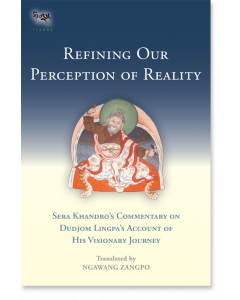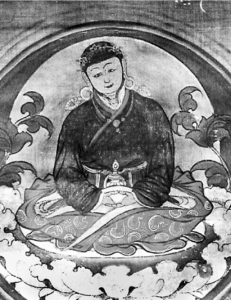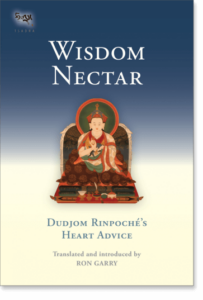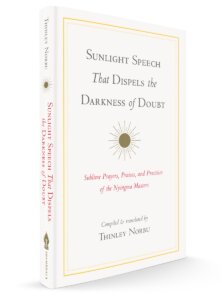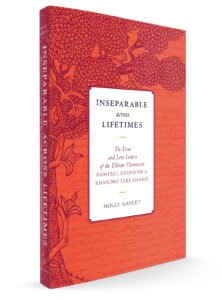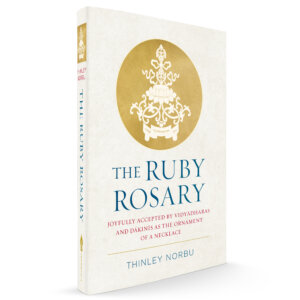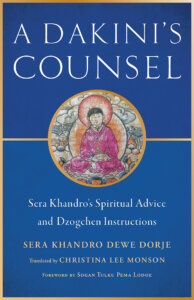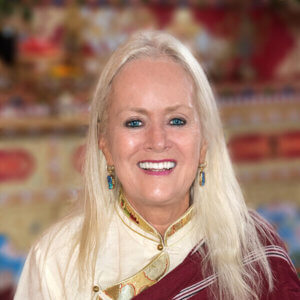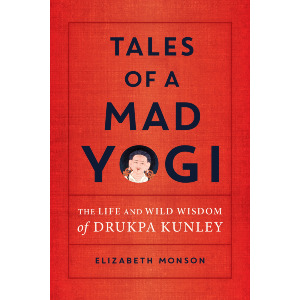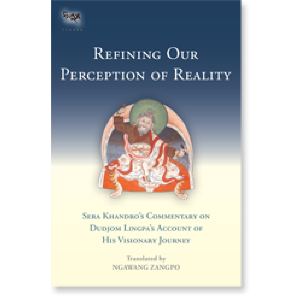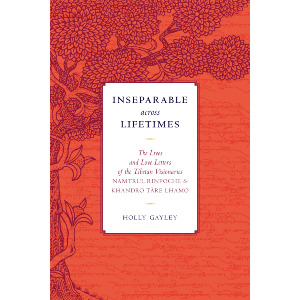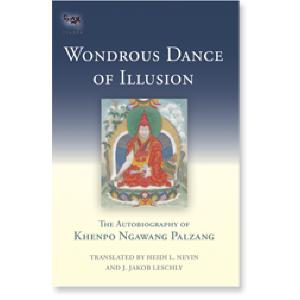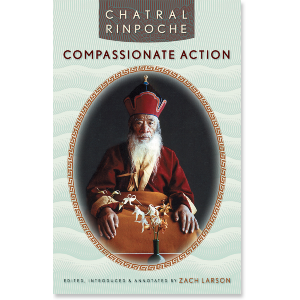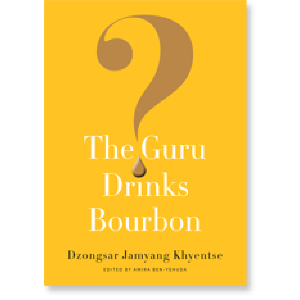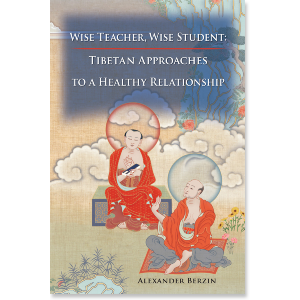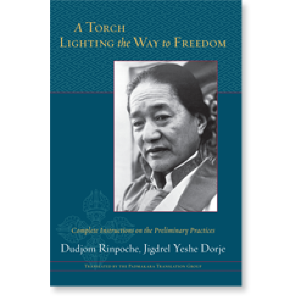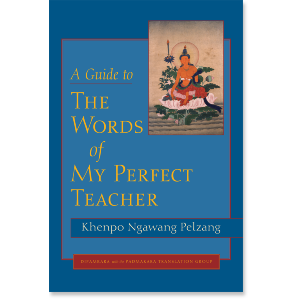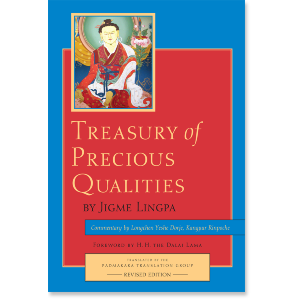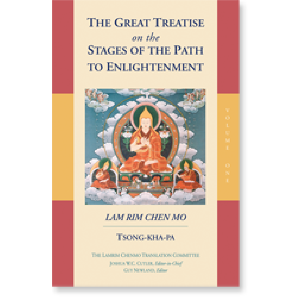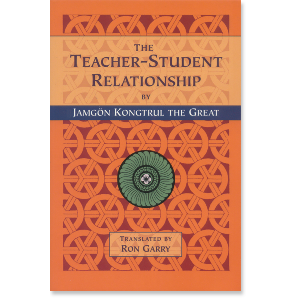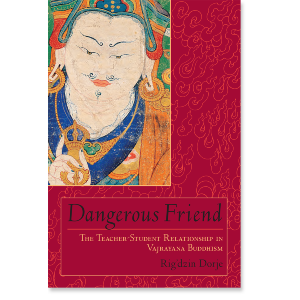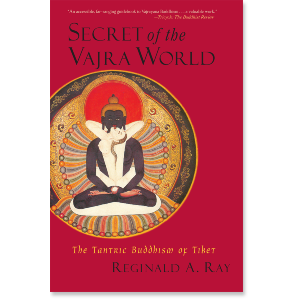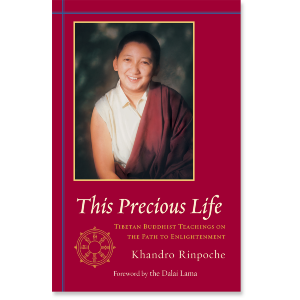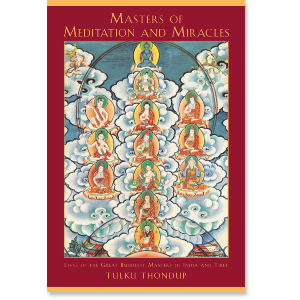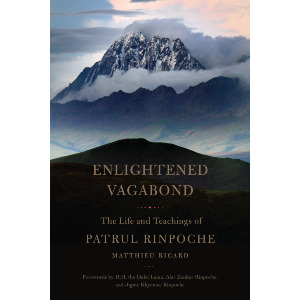Sometimes The Only Thing to Do is Pray
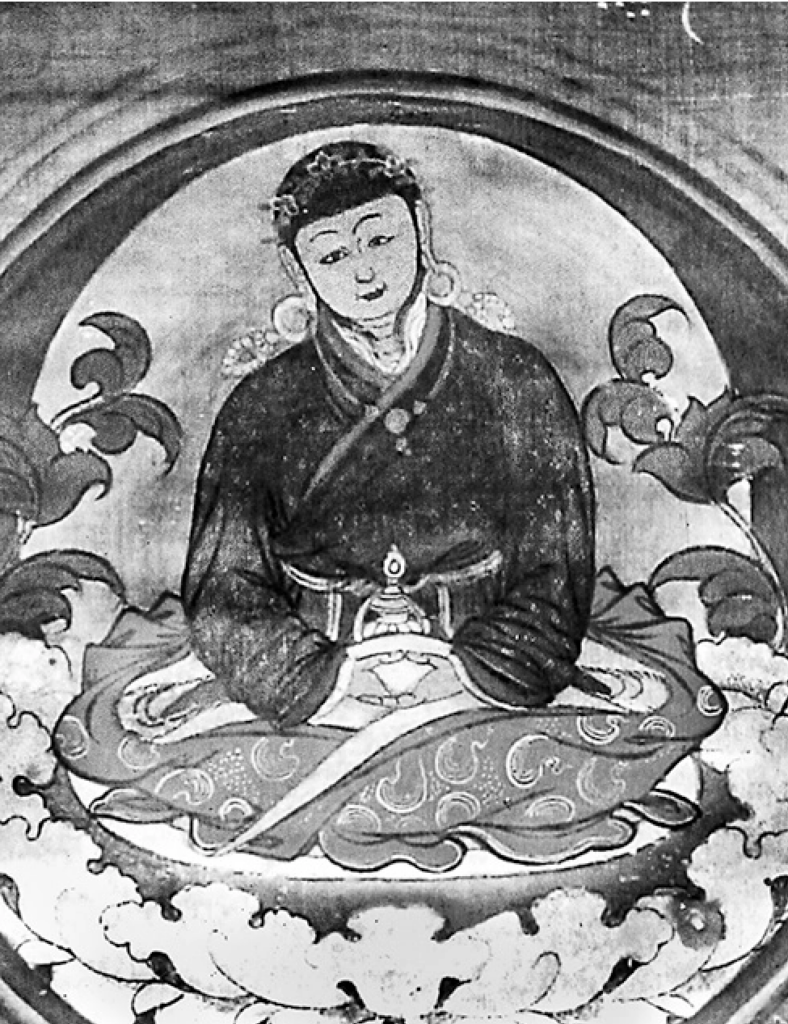

Sera Khandro
Sera Khandro (1892–1940) was one of the most prolific Tibetan female authors of the past several centuries. At the age of fifteen, she left her home in Lhasa for eastern Tibet, embarking on a lifetime devoted to her spiritual path—she became a spiritual master, a revealer of ancient hidden teachings, a mystic, a visionary, a writer, a mother, and a vagabond. Her written works and spiritual lineage have been preserved and are now cherished worldwide.
Sera Khandro
-
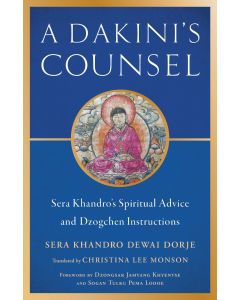 A Dakini's Counsel$26.95- Paperback
A Dakini's Counsel$26.95- PaperbackBy Sera Khandro
Translated by Christina Monson
Foreword by Dzongsar Jamyang Khyentse
Foreword by Sogan Tulku Pema Lodoe
GUIDES
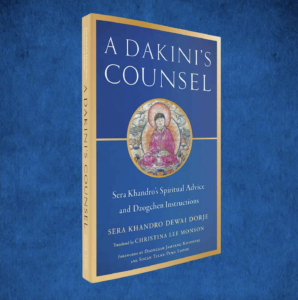
Sometimes the Only Thing to Do is Pray: An Excerpt from A Dakini's Counsel
A Selection from Chapter 1
Excerpted from A Dakini's Counsel: Sera Khandro's Spiritual Advice and Dzogchen Instructions
By Sera Khandro
Translated by Christina Monson
About This Title
Sera Khandro Dewai Dorje was a modern Tibetan Buddhist teacher who single-pointedly pursued a life of Dharma while balancing family life and public teaching. This collection of her advice, prayers, dreams, prophecies, and treasures (terma) is both biographical and instructional. It comes from within the tradition of Dzogchen, replete with practices for resting in the nature of mind. This lineage forms the bedrock of Christina Monson’s own spiritual path, lending a deep intimacy to the translations, which serve as a window into Sera Khandro’s life, teachings, and rich inner experience.
Prayer
Chapter 1, page 1-6
Sometimes the only thing to do is pray.
In the Buddhist tradition in general, to pray is to surrender to the infinite manifestative potency of interdependence: causes and conditions coming together such that anything and indeed everything is possible. In the Great Perfection tradition, prayer often carries a deeply devotional flavor, reflecting the special relationship between teacher and disciple at the core of its authentic transmission. Dewai Dorje’s unbounded devotion, love, and joy frequently burst forth through prayers. These sublime portals into her inner world reveal ways she worked with some of the most powerful emotions of her life and experienced their fullest transformative potential. Similarly, she grounded herself in times of bottomless pain, grief, and sorrow through expressions of heartfelt longing and aspiration. Her intimacy with the vast spectrum of human feeling shines through the numerous prayers she composed throughout her biographical writing and treasure revelations.
Chapter 1 welcomes us through prayer into Dewai Dorje’s sea of deep love as seen for and through the eyes and heart of her lama and consort, Drime Ozer. We are treated to a glimpse of their relationship through this first piece, “An Offering from the Vulture to the Cuckoo,” a poetic letter authored by Drime Ozer himself. While all other selected translations here were penned by Dewai Dorje, this unique prayer is a rare piece of his original writing. Little of the bulk of Drime Ozer’s treasure collection, unlike that of his father Dudjom Lingpa, appears to have survived the turmoil of post 1959 Tibet. However, some selections of his writing, ritual practice compositions, and profound instructions are included in Dewai Dorje’s Collected Works. A notable exception is his longest known existent work, an as-yet untranslated commentary on the meaning of his father’s seminal teaching Buddhahood without Meditation.
Drime Ozer’s letter to Dewai Dorje takes us into their multidimensional connection as he lauds her special qualities and prays for her longevity. Half prayer, half poem, the language overflows with reverence and love for her. The second half tells the tale of a white vulture and a cuckoo to intimate the connection between Drime Ozer and Dewai Dorje with metaphoric imagery. This unique love language, drawing from the natural world, is found elsewhere in Dewai Dorje’s writings. In the poem that directly follows this prayer, seemingly as a response to it, she tells the tale of a “blue lady cuckoo” who perfects Secret Mantra practice and concludes,
These secret words about secret conduct,
inspired by the white vulture [Drime Ozer],
naturally occurred from whatever arose.
She also refers to Drime Ozer as a “white vulture” in his biography.2 There she recounts a dream where Drime Ozer meets his father Dudjom Lingpa, who instructs him to unite with the magical emanation of Vajravarahi, Dakini Sukha Vajra (Dewai Dorje), to overcome negative circumstances in his life. Dudjom Linga predicts,
Hey, hey!
When the luminescence of the eastern sky
is welcomed by the roar of the southern turquoise dragon [Dewai Dorje]
and the triple-skilled white [vulture] soars in space,
if splendor and thunder come together,
they are sure to make harmony as one.
The words of the cryptic prophecy continue but clearly refer to him and Dewai Dorje. As further evidence of their prophesized connection beyond the confines of time and space, Drime Ozer makes mention of her connection to his past lives. Some of these specific incarnations are also identified by Dewai Dorje in Drime Ozer’s biography where she lists, “At Yarlha Shampo, he was born as Pema Ledrel Tsal. At Dragdra Drogmoche, he was Longchen Dorje Ziji. At Tarpaling in Bumthang, Bhutan, he came as Pema Lingpa. At Yarlung, he was born as Urgyen Samten Lingpa.”
Such long-term connection stretching across lifetimes defies ordinary notions of relationship. It is a repeated theme between Dewai Dorje and Drime Ozer. The topic of Drime Ozer’s past incarnations comes up again in “The Ennobling Deeds of All Buddhas and Their Heirs.” There, his past lives as important treasure revealers are emphasized. The Nyingma tradition holds as a core tenet that the activities of realized beings include the revelation of treasures. Myriad in form and modality, treasures are encrypted wisdom teachings. The tradition identifies one hundred masters who are considered great treasure revealers, including five considered to be especially significant.3 Dewai Dorje’s list of Drime Ozer’s past lives name at least four with the treasure revealer name Lingpa: Pema Lingpa, Urgyen Samten Lingpa, Dodrul Lingpa, and Rok Dechen Lingpa.
Notable as well in the first prayer is the way Drime Ozer refers to Dewai Dorje using different names. He begins the homage by introducing the three kayas, dimensions of wisdom form. These are the dharmakaya, which is connected to mind’s empty essence, the sambhogakaya, which is connected to mind’s lucid and blissful nature, and the nirmanakaya, which is connected to mind’s compassionate capacity.4 Dakinis, wisdom manifesting through the feminine principle, are present in each dimension. In paying homage to Vajravarahi (Dorje Phagmo), Dewai Dorje’s principal tutelary deity, he is revering Dewai Dorje herself as a manifestation of mind’s empty and blissful unity. Her special connection with this deity is also further reflected in references to Khacho, the buddha field connected with Vajravarahi.
Dewai Dorje was a practitioner who had mastered the yogic teachings found in the inner tantric approach of anuyoga. These are powerful techniques for directly actualizing the potential of the body’s subtle network of energy channels, winds, and vital essences to enable realization of primordial wisdom. Relying upon both one’s own and another’s body, the anuyoga practitioner induces experiences of bliss to swiftly catalyze and deepen recognition of mind’s nature. As restrictions to the movement of wisdom winds through the body are lifted, the practitioner’s capacity to encounter the entirety of perceptual experience as teacher and teaching and as phenomena of purity is enhanced. In this context, “wind-mind” is a designation used to refer to the mobile aspect of consciousness, refined and rendered pliable through these practices.
Indeed, Drime Ozer himself was a master who had fully perfected the techniques of anuyoga as well. As such, he was a fully qualified consort for Dewai Dorje, her “heruka of great bliss,” as she too was for him. Heruka is a Sanskrit term indicating a wrathful, “blood-drinking” deity. As a tantric couple, Drime Ozer and Dewai Dorje practiced divine union as a yab yum (masculine and feminine) couple, using visualization of the wrathful deities Hayagriva and Vajravarahi and other techniques. Their special relationship thus involved being destined tantric partners for each other, as well as having a mutually reciprocal guru-disciple bond. Dewai Dorje’s love and devotion for Drime Ozer as her lama, consort, and treasure-revealing partner are paramount themes throughout her writing.
She celebrates his realization in “The Accomplished Secret Mantra Yogi.” Likening him to the primordial Buddha Samantabhadra and the Second Buddha Padmasambhava, the great Indian adept who helped the Tibetan king Trisong Deutsen overcome obstacles to the propagation of the Buddhadharma in Tibet in the eighth century, she lauds his exalted level of realization. To see “the truth of ultimate reality,” as he did, is to directly encounter the empty yet luminous nature of mind precisely as it is, within the context of the Great Perfection. This approach—which emphasizes such an encounter and the subsequent training of familiarity with it until stability is achieved—is the only way to untangle the web of dualistic thinking and its mistaken understanding of reality. It’s the only place where freedom from the confines of conceptual mind is found. This is what enabled Drime Ozer to “dance” with “wisdom’s illusions”: to be in the world of relative appearances but not be enslaved by them. This, of course, is made possible through realizing nothing that appears truly exists. Rather, according to Dzogchen, phenomenal existence is none other than a manifestation of the ground from which it arises: luminous, empty awareness. For Dewai Dorje, Drime Ozer’s realization of this fundamental truth made him a buddha, transcending even the limitation of necessarily appearing in a body made of flesh and blood.
“Prayer of a Crazy, Carefree Lady” uncovers more subtle qualities of his meditative presence, while “The Ennobling Deeds of All Buddhas and Their Heirs” unfolds Dewai Dorje’s utter disbelief and joy at having him in her life, as well as her despair at not being with him. This prayer is dated to the Tibetan year of the Dog. This may refer to 1911, according to the Western calendar, a time of intense turmoil for Dewai Dorje as she struggled to find her way without family or support as an outsider in the communities of eastern Tibet, where she had newly arrived.
The remaining prayers in the chapter unfold other dimensions of Dewai Dorje’s life in early nineteenth-century Golok. “I Supplicate Pema Totreng Tsal” laments the hypocrisies of fake treasure revealers. Dewai Dorje lived within a world of Dharma communities shaped by beliefs about the continuity of spiritual teachings from Guru Padmasambhava and his Tibetan consort Yeshe Tsogyal in eighth-century Tibet up to her own time and place in early twentieth-century eastern Tibet. These treasures were hidden in the physical world as well as in the intangible domain of the minds of those who were destined to discover them, the treasure revealers. The various mechanisms of their revelation and dissemination made sacred the landscape of Dewai Dorje’s life.
Even so, against such a highly sacrosanct backdrop, deceit existed. The degeneration of pure Dharma teachings and traditions for its followers is one sign of what made that time “dark” for Dewai Dorje. While Buddhist cosmology stemming from Indian sources labels the current age one of dissolution when all things decline, Dewai Dorje identifies in this prayer specific negative characteristics of treasure revealers proximate to her in time and space. To ensure she remains free from such bad behavior, she concludes with an aspiration for the circumstances of her authentic Great Perfection practice to prevail.
Remaining selections include a refined overview of the view, meditation, and conduct of Dzogchen according to her personal experience and practice as well as a synthesized version of some of the most important moments of her life. Much of Dewai Dorje’s writing teaches through the way it reflects her own realization. Prayers blend with delicate expressions of insight and wisdom such as the final prayer to Yeshe Tsogyal. This, a supplication to Padmasambhava and Yeshe Tsogyal, presents the progressive unfolding of the visions of pure appearances induced through the Dzogchen practice of Togal. Dewai Dorje’s familiarity with the visions of Togal speaks to her stable recognition of awareness, as these appearances of purity both depend upon and enhance a practitioner’s authentic experience of it.
Sera Khandro (1892–1940) was one of the most prolific Tibetan female authors of the past several centuries. At the age of fifteen, she left her home in Lhasa for eastern Tibet, embarking on a lifetime devoted to her spiritual path—she became a spiritual master, a revealer of ancient hidden teachings, a mystic, a visionary, a writer, a mother, and a vagabond. Her written works and spiritual lineage have been preserved and are now cherished worldwide.
Christina Monson (1969–2023) was a Buddhist practitioner and teacher and Tibetan language translator and interpreter. She had over thirty years of study, translation, and practice experience in Buddhism beginning with an interest in Asian philosophy as an undergraduate student at Brown University. Later, she focused her studies on Tibetan Buddhism while completing a master’s degree at the University of Wisconsin–Madison. She journeyed to Nepal in 1989 where she met her root guru, Chatral Sangye Dorje Rinpoche, under whose guidance she studied and practiced in periods of intensive retreat for the next twenty-seven years. Chatral Rinpoche first introduced her to the person and treasure lineage of Sera Khandro Dewai Dorje and conferred empowerment, reading transmission, and practice instructions. She spent the last several years of her life translating Sera Khandro’s sheldam (instructions) into English as a Tsadra Foundation translator and scholar, along with teaching and practicing the Dharma.
Related Books on Sera Khandro

Heart Advice: Pronouncements Before Passing
Heart Advice: Pronouncements Before Passing
A Selection from Chapter 8
Excerpted from A Dakini's Counsel: Sera Khandro's Spiritual Advice and Dzogchen Instructions
By Sera Khandro
Translated by Christina Monson
About This Title
Sera Khandro Dewai Dorje was a modern Tibetan Buddhist teacher who single-pointedly pursued a life of Dharma while balancing family life and public teaching. This collection of her advice, prayers, dreams, prophecies, and treasures (terma) is both biographical and instructional. It comes from within the tradition of Dzogchen, replete with practices for resting in the nature of mind. This lineage forms the bedrock of Christina Monson’s own spiritual path, lending a deep intimacy to the translations, which serve as a window into Sera Khandro’s life, teachings, and rich inner experience.
Heart Advice
Chapter 8, page 341-350
For Buddhist practitioners, death is an extraordinary opportunity. For it is that moment, when consciousness separates from the confines of physical form, that luminosity dawns and blazes as never before. Those who can seize the moment, by recognizing what is, are liberated on the spot. For others, subsequent events present further portals for recognition as the phenomena of the bardo unfold. Given the potency of the death experience for awakening, the Tibetan tradition as a whole, and especially the Dzogchen tradition, offer a plethora of skillful supports for the dying.
It is a natural inclination for those sensing into their own deaths, whether imminent or not, to want to say what is most important before the opportunity to do so is gone. To fully internalize the truth of death leads to speaking the truth, however and whatever that may entail for an individual. In this context, the tradition of final testaments (zhal chems), teachings and advice offered as the most essential by masters to disciples, enriches Tibetan Buddhism as a whole and especially the world of shaldam. Dewai Dorje’s writings contain several such selections, two of which conclude this final chapter.
“Heart Advice, A Final Testament,” written for Drime Ozer, covers with deeply felt earnestness crucial instructions on practicing most aspects of the path. Combining spiritual and practical advice, Dewai Dorje holds nothing back in telling her beloved exactly what she thinks he should and shouldn’t do. The intimacy between them is revealed in the moving and genuine pronouncements of what she sees would be dangerous for him. This degree of comfort and familiarity speaks to a relationship between heart Dharma friends, stripped of the formalities that otherwise could color communication between individuals of differing status within the tradition. Dewai Dorje taught Drime Ozer as an equal in a relationship of loving mutuality.
The final piece, “A Beggar Lady’s Final Testament,” combines the highest Dzogchen instructions with foundational Dharma advice. Written for monastics, it synthesizes Dewai Dorje’s indispensable counsel. For those who need something concise and easy to implement, this can be taken everywhere. It is as relevant for Dharma practitioners today as it was for her community one hundred years ago.
While neither of these final testaments is dated, Dewai Dorje might have written them at any time over her decades of life in eastern Tibet. From its language, the first likely was written before the passing of Drime Ozer in 1924. It’s not unusual for teachings labeled as final testaments to be composed well before a master’s actual passing. Genuine practitioners are steeped with the truth of impermanence and know that death can arrive at any moment. The urgency therefore to say what is most crucial is always upon them. What would be possible if such were the case for all of us?
Heart Advice, A Final Testament
How wondrous!
Superb Heir of All Victorious Buddhas,
gone before, present now, and still to come,
Secret Consort throughout All Lifetimes,
Great Hero—please, hear me.I have little freedom,
since my past accumulation of merit and wisdom was weak.
I have fallen under the control of others,
and as I am forced to wander in faraway places,
my despair never lifts.I have no desire to leave you, dearest partner,
equal to my heart, eyes, and very life.
But when negativity forces us apart for a little bit,
please, listen to this heart advice,
a final testament of what I am thinking.Transmitting the mani mantra to the Great Compassionate One,
or teaching sentient beings in the presence of Buddha—
this is not what I am doing.
Since our hearts are harmoniously intertwined
and we have great love and pure samaya between us,
I am just telling you what I think,
without hiding or changing anything.Visualize your father and lama,
the actual buddha of triple time,
Dudjom Dorje Drolo Tsal [Dudjom Lingpa]
constantly upon your crown.
Since he’s unrivaled among hundreds of lamas,
you don’t need to rely on others,
as there is the danger of breaking samaya.Yidam deities, empty in their appearing, arise as the lama
and are perfected as an expanse of self-arisen supports and supported manifestations.
You don’t need development practice that fixates on these appearances.
This brings the danger of falling into perpetual reification.Mantra’s speech is the language of the unborn, emptiness.
Breathing in and out is the wheel of mantra.
You don’t need to count mantra recitation conceptually.
You risk breaking its continuity with pointless chatter.Self-arisen mind, beyond causes and conditions,
is spontaneously present as an exalted state of primordial perfection.
You don’t need to use antidotes of accepting and rejecting.
These carry the danger of obscuring the twofold radiance of wisdom.Present in and of itself and uncompounded,
the dynamic energy of space and awareness
appears as kayas and orbs of five-colored light.
This is the actualization of the natural radiance of the four visions and six lamps.
You don’t need to rely upon mere relative interdependencies.
These bring the danger of temporary visual experiences of light rays.In the illusory displays of dakinis, mind’s magical manifestations,
connate primordial wisdom arises as the dakinis’ creative power.
You don’t need to hold these as separate and distinct.
Doing so risks inviting unwanted punishment.The miraculous display of the haughty protectors’ wrath
steals the life force of any enemy that is visualized.
Killing for meat and beating drums is pointless.
Misunderstanding the messengers risks harming yourself.Wrathful, supreme method, the body of the vajra king
penetrates the bhaga of the queen of unchanging space.
You don’t need beautiful human seductresses.
They bring the danger of losing the potency
of your channels, winds, and vital essences.Supreme accomplishment is evidenced by the power to reveal profound treasures,
which are to be held as precious as life itself without any disrespect.
You don’t need to compose teachings using the conventional language of intellectuals.
Doing so risks profound teachings falling into the hands of transgressors.Upon the face of the clear mirror of self-arisen phenomenal existence,
the symbolic writing of the mother-dakinis appears in images.
Practice these, the dakinis’ oral instructions, precisely as they should be.
You don’t need to seek divination about the chaotic appearances of delusion.
That brings the danger of being deceived by evil spirits.Through powerful and persistent prayers, genuine Dharma holders,
endowed with spiritual wealth yet humble in appearance,
will come to your door.
View them wisely, protect them,
and give them ripening and liberating instructions.
You don’t need to live according to others’ ethics.
Doing so puts you in danger
of wrong intentions, obstacles, and negative circumstances.The spread and supervision of profound Dharma teachings
are controlled by the dakinis of ultimate reality.
You don’t need to cater to the wishes of ordinary humans.
That carries the danger of mistaking the timing of Dharma teachings.When the father’s riches are mined by the son,
empty awareness, the best wisdom-dakini partner,
is taken as the siddhi beyond method and wisdom.
You don’t need human ladies as consorts.
This risks entanglement with one who isn’t your destined partner.The sole heart son Natsok Rangdrol
will rely on only you as refuge, now and in the future.
Protect him lovingly, and kindly give him the profound teachings.
You don’t need to go to Gangri Tokar.4
There’s the danger of getting sick and dying.When you instruct students in both worldly and spiritual matters,
some cannot be tamed by gentleness and need wrath,
and some cannot be tamed by wrath and need gentleness.
Care for all beings with fearless conduct.
You don’t need to hope, fear, or pretend anything.
Pandering to others risks giving them control of your mind.For transgressors untamed by either wrath or gentleness,
incite the powerful display of the haughty protectors as opponents
who will wipe them out until nothing, not even their names, remain.
You don’t need to talk idly with transgressors.
Doing so risks getting lost in their wildness.Food taken and clothing worn
are the wheel of the two accumulations,
enjoyments to be invested as ornaments.
Don yourself with nice clothing and enjoy special foods!
You don’t need to eat and dress like a beggar.
Doing so risks offending the wisdom deities in your body’s mandala.When enacting great deeds for the teachings of the Buddha and beings,
if you stay in retreat, you will accomplish benefit for self and other.
You don’t need to run around on horseback doing village rituals.
Doing so risks being affected by obscurations of ripened karma.Trust only yourself.
You don’t need the competition and conflict of friends and enemies.
Sweet talkers with hearts of black smoke
bring the danger of losing your freedom to others.Without feeling discouraged by all these faults,
focus on serving the Buddha’s teachings and sentient beings.
The word death is just a bubble.
Your own perception will dawn as a buddha field,
present in and of itself.
Sera Khandro (1892–1940) was one of the most prolific Tibetan female authors of the past several centuries. At the age of fifteen, she left her home in Lhasa for eastern Tibet, embarking on a lifetime devoted to her spiritual path—she became a spiritual master, a revealer of ancient hidden teachings, a mystic, a visionary, a writer, a mother, and a vagabond. Her written works and spiritual lineage have been preserved and are now cherished worldwide.
Christina Monson (1969–2023) was a Buddhist practitioner and teacher and Tibetan language translator and interpreter. She had over thirty years of study, translation, and practice experience in Buddhism beginning with an interest in Asian philosophy as an undergraduate student at Brown University. Later, she focused her studies on Tibetan Buddhism while completing a master’s degree at the University of Wisconsin–Madison. She journeyed to Nepal in 1989 where she met her root guru, Chatral Sangye Dorje Rinpoche, under whose guidance she studied and practiced in periods of intensive retreat for the next twenty-seven years. Chatral Rinpoche first introduced her to the person and treasure lineage of Sera Khandro Dewai Dorje and conferred empowerment, reading transmission, and practice instructions. She spent the last several years of her life translating Sera Khandro’s sheldam (instructions) into English as a Tsadra Foundation translator and scholar, along with teaching and practicing the Dharma.
Related Books on Sera Khandro

The Passing of Christina Monson
The Passing of Christina Monson

We are deeply saddened to share the news that Christina Monson—teacher, translator, and disciple of Chatral Rinpoche among others—passed away November 19, 2023.
Christina's book, A Dakini's Counsel: Sera Khandro's Spiritual Advice and Dzogchen Instructions will be released May 21, 2024. We knew she had little time left after her cancer diagnosis earlier this year. We had hoped she could hold the book in her hand, but she knew it was in a good place.
All of us at Shambhala Publications have our palms together to Christina for her ceaseless contributions to the Dharma generally, the Nyingma tradition, the Dudjom and Sera Khandro lineages specifically.
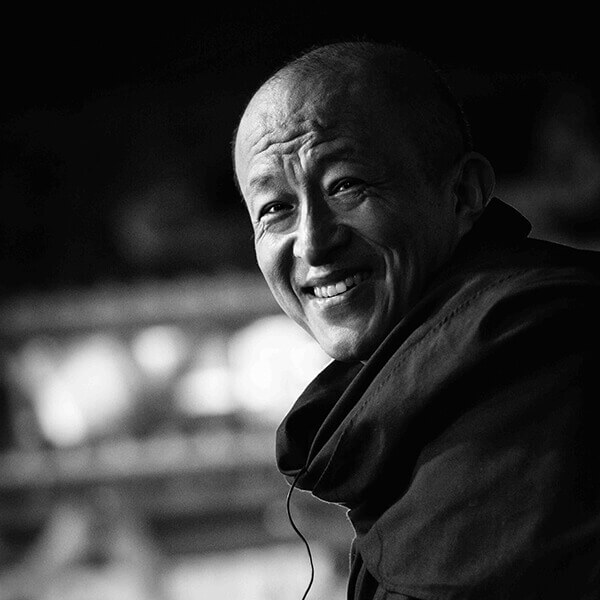
In addition to receiving teachings, abhishekas, and guidance from many great Mahasandhi masters—for example, Tulku Urgyen Rinpoche—Christina Monson also received decades of teachings from Kyabje Chatral Rinpoche. Therefore, I do not think of her as yet another mildly curious Dharma student but as a seeker after the truth who has been blessed and strongly influenced by many great masters, Chatral Rinpoche in particular. As such, I have no doubt that Christina made many good aspirations as she translated Sera Khandro’s words, and, as a result, now that this great lady’s words are being made available in English, there is far less chance of the meaning getting lost in translation. For this reason, my aspiration for this translation is that it will be widely read. May those who read this book not only come to know Sera Khandro and her teachings but may the reach of her buddha activities extend to infinity.
There have been an outpouring of appreciation for Christina as she was a mentor, friend, and dharma sister to so many.
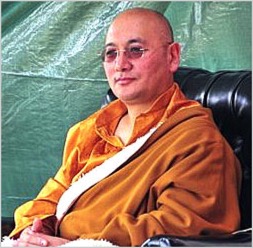
And when my Dharma siblings who I wished to remain here with me inseparably
Are led away without hope of intervening, by the Lord of Death himself, I feel sad
But sadness and grief don’t help; let us rouse strength of heart
And spurn ourselves to practice virtue and dedicate it with aspirations.
You can download the full prayer here.
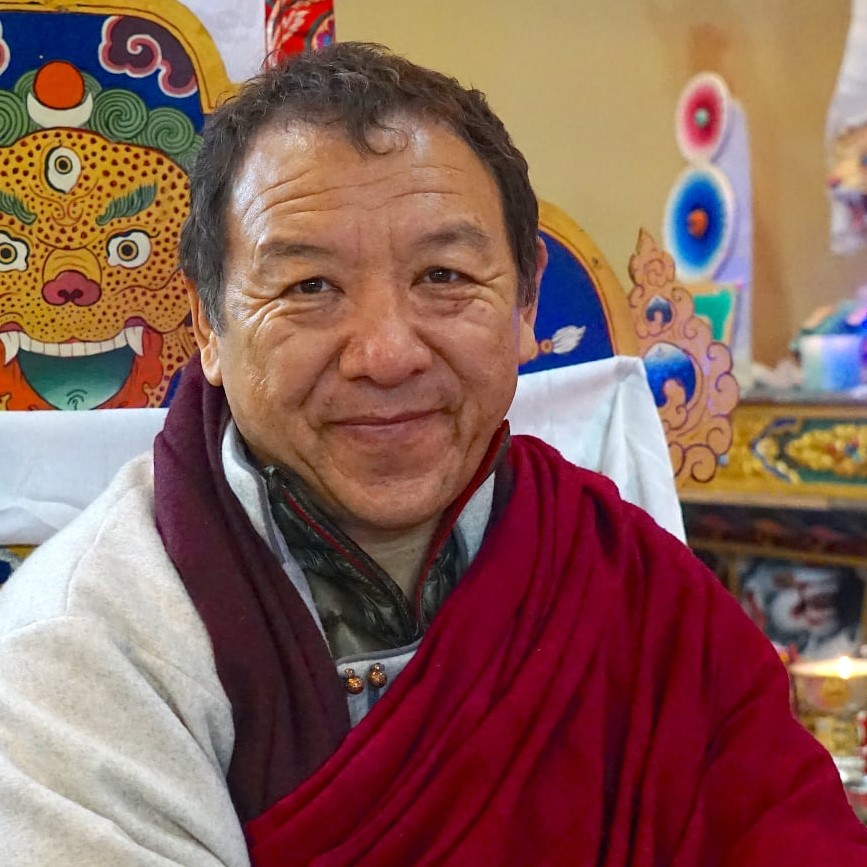
"She was a great practitioner during her lifetime and she was an example of how to be a Vajrayana student. She kept her samaya and bodhicitta mind throughout her life excellently. She was so kind and her teachings were immensely beneficial to the members of the Padmasambhava Meditation Center and many other sanghas. I am very grateful for everything she has done.
I have no doubt that Christina is in a very good place and I personally witnessed a rainbow around the sun on the day that she passed. I am personally sponsoring many practices for her.
I would request that everyone do prayers for her. Please recite Vajrasattava, Chenrezig, Guru Yoga and whatever practice you do and dedicate it to Christina's full enlightenment."
"It’s hard to write this but important. As we were receiving the Kudong of Wangdu Rinpoche at Tara Mandala November 19, 2023, the great Yogini and Translator Sangye Gyalmo, Christina Monson integrated her consciousness into the Dharmakaya and passed from this world. I last met her in July and we spent ten days together. I really wanted her to live, she had so much more to give and to translate. I wanted her to come out from the role of translator and teach and she would have, but sadly for us this was not to be in this life… but let us pray for her rapid rebirth. A great Yogini has departed from this world and she should be honored as such. One of the last things she said to me as she was dying was
'Your personal practice is all that matters in the end.'
She remained in tugdam 3 days in Oakland and left a trail of rainbows.
Her book “A Dakini’s Counsel” will come out next spring and she sent me the manuscript to write an endorsement, which I happily did. Here is a fragment from it, it is a poem from her consort Drimé Ozer about Sera Khandro. I pulled it spontaneously from the manuscript and I think it applies to Christina as well.
From "An Offering from the Vulture to the Cuckoo" by Drime Ozer:
Reflecting on all your noble qualities deepens my faith.
Seemingly I’m lost, an ordinary person
controlled by the five poisons.7
But the manifestative potency of your great bliss wisdom
automatically connects my body, speech, and mind to their vajra essences
and introduces me to undistracted luminosity,
my true dharmakaya nature.
Extraordinary is your great kindness,
Noble Lady, my Wish-Fulfilling Jewel.The ultimate expanse
is definitely devoid of characteristics to fixate upon.
Yet, from the perspective of disciples who are training,
teacher and retinue seemingly appear.The fundamental nature of reality
is but a single indivisible sphere.
Yet, those with impure perception
see it as distinct from confusion.In essence, awareness transcends fears
about birth and death,
but for those who cleave to permanence,
dying and becoming seemingly appear.Most certainly you have mastery
over the phenomena of samsara and nirvana,
yet you continuously practice
the two stages of development and completion.
Related Books
By Christina's sister Elizabeth:
Books Related to Sera Khandro
Books Related to Chatral Rinpoche
$39.95 - Hardcover
By: Heidi L. Nevin & J. Jakob Leschly & Khenpo Ngawang Pelzang & Khenpo Ngawang Palzang
Christina Monson on the Naturalness of Illness, Dakini Guidance, and Chatral Rinpoche

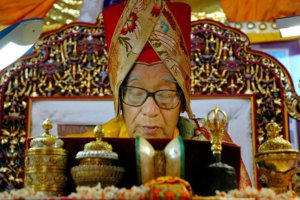
The Role of the Teacher in Tibetan Buddhism: A Reader's Guide to the Teacher-Student Relationship

To truly understand Tibetan Buddhism, one must come to grips with the unique role of the teacher, the dynamics of the teacher-student relationship, and the possibilities that having a teacher can open up.
Tibetan Buddhism is composed of the Vajrayana or Tantric teachings on top of a foundation of the Sutrayana (vehicle of the Sutras), the core teachings of what are sometimes called the Sravakayana and the Mahayana. In the context of the Sutrayana, a relationship with a teacher roughly maps to the categories of a pratimoksha master and a master of the bodhisattva vows, but there is a wide scope of possibilities and overlap within these roles. The teacher imparts, for example, important points on shamatha or vipashyana meditation, philosophy, or techniques like mind training (lojong), and these are akin to the role of teachers in other Buddhist traditions.
But in the relationship with a male or female vajra master in the context of tantric teachings, including Mahamudra and Dzogchen, the teacher and student have very specific commitments to each other, which is a very different situation. While this relationship may very well incorporate the elements of the relationship with a Sutrayana teacher, it is important for people to understand that a Vajrayana teacher is not really akin to the role of the Zen priest or the spiritual friend (kalyāṇamitta) of the Pali tradition of Buddhism, let alone the Hindu Guru, therapist, or a modern-day life coach. The practice of Guru Yoga (see sidebar below), whereby the student visualizes their teacher in the form of an enlightened being is one example of how different things are in this context. The relationship is much more central and is an essential mechanism for making great strides on the path.
That is why traditional texts encourage people to spend up to 12 years carefully considering whether a teacher of Vajrayana is suitable for them. They are not encouraging people to be wishy-washy and put off making a commitment; rather, this number underlines the importance of choosing a teacher very carefully.
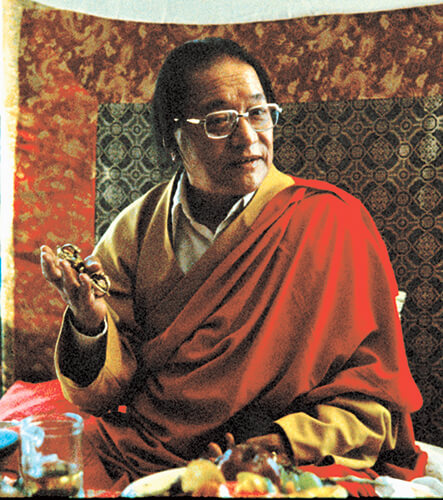
The benefits are immeasurable and are not accessible without a teacher. The great 20th-century master Dudjom Rinpoche gives some traditional examples to demonstrate the importance:
Ordinary, childlike beings are incapable of proceeding even vaguely in the same direction as the perfect path by the strength of their own minds, so they need first to examine and then to follow a qualified diamond master. Diamond masters are the root that causes us to correctly engage in the whole Buddhadharma in general and especially to follow the path properly. They are knowledgeable and experienced guides for inexperienced travellers setting out on a journey, powerful escorts for those who are travelling to dangerous places, ferrymen steering the boat for people crossing a river. Without them, nothing is possible. This is reiterated in countless scriptures.
Recently, there has been a lot of news and discussion in the media, Buddhist and otherwise, around the role of the teacher in Buddhism—in particular, Tibetan Buddhism. This mostly relates to a small handful of teachers (including the leader of Shambhala International, an organization totally unaffiliated with Shambhala Publications) against whom there have been serious allegations of abuse of power, some of it sexual. Many of these articles have been read by a younger generation of Westerners curious about Buddhism and other spiritual traditions but suspicious of hierarchy, organized religion, and spiritual leaders with perceived authority. This media attention seems to validate their suspicions.
But however bad some of these cases are—and it should go without saying that someone who is causing harm is acting in complete opposition to the Buddhadharma—a teacher harming or taking advantage of a student is an unacceptable exception to the norm; it is a rare aberration in an incredible system that has benefited millions of people East and West in the most profound and transformative ways.
These aberrations are not new. People are human, and throughout Buddhist history (or any tradition) there has been the occasional charlatan or flawed leader—as the discussion of how to avoid a bad teacher in many of the texts below make plain. But the fact is that there are so many highly educated, spiritually accomplished (typically following many years in retreat), caring, selfless teachers in this tradition, and it is a shame that people who do not know better are being exposed, online and in print, only to the exceptions rather than the norm and the potential.
Specifically, much of the recent coverage and discussion online and in print around the role of the guru or lama has reflected a deep misunderstandings of the role of the teacher in Tibetan Buddhism and has therefore created a lot of confusion. The best way for a student to find the right teacher who can lead them far along the path to enlightenment is to have a solid ground in understanding what the roles are, to be aware of the cultural dynamics at play, and to know which qualities to seek and which to avoid.
So, we are pleased to share this Reader’s Guide to help those interested in understanding the role, importance, and centrality of the guru or lama and the transformative power of the student-teacher relationship. We hope this will better prepare those pursuing this path to understand the choices they are making and set them up for spiritual success and accomplishment.
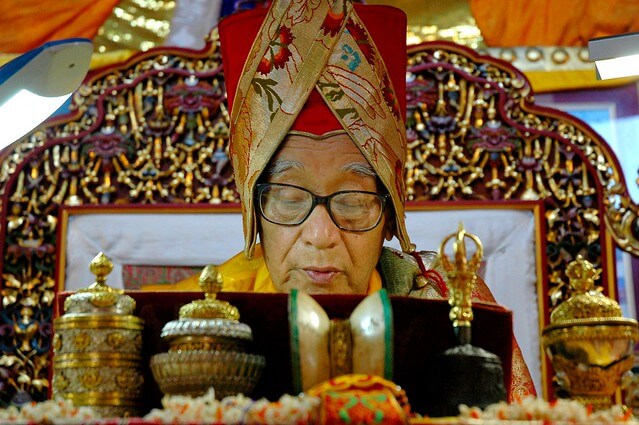



Perhaps the book that addresses head-on the contemporary concerns and confusion about the role of the teacher—from gender inequality to power dynamics and bad apples—is Dzongsar Khyentse Rinpoche’s The Guru Drinks Bourbon. This is a thrilling modern guide to help students understand what they are in for and what is expected of them. It is, after all, a two-way street. He covers many areas and, while acknowledging a checklist is too simple of a model, he does present some helpful guidelines.
“The good guru
- has realized the ultimate view
- is open-minded
- is reluctant to teach
- is tolerant
- is learned
- is disciplined
- is kind and never denigrates others
- has a lineage
- is progressive
- is humble
- is not interested in your wallet, thighs, or toes
- has a living guru and a living tradition
- is devoted to the three jewels
- trusts in the laws of karma
- is generous
- brings you to virtuous surroundings
- has tamed the body, speech, and mind
- is gentle and soothing
- has pure perception
- is nonjudgmental
- abides by the Buddha’s rules of Vinaya, Bodhisattvayana, and, of course, Vajrayana
- fears wrongdoing
- is forgiving
- is skillful"
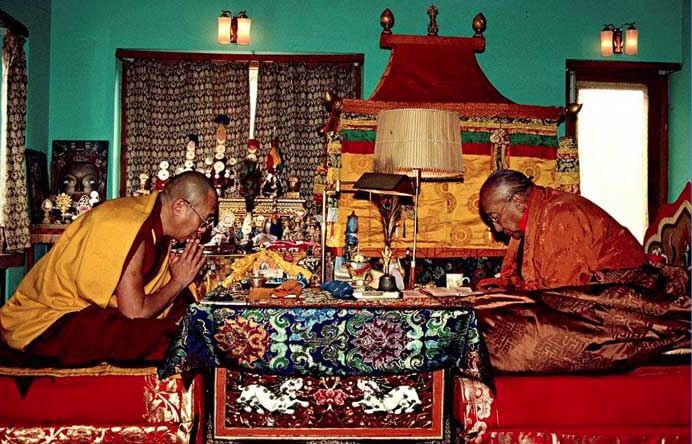

Another book exploring the student-teacher relationship is Alex Berzin’s Wise Teacher, Wise Student: Tibetan Approaches to a Healthy Relationship. The work covers many of the traditional topics but also gives a lot of thought to contemporary issues, cultural differences, and Westerner-specific issues like paranoia and vulnerability. He brings in some models from psychology (transference and regression) to explain many of the dynamics Westerners may present and how students can overcome them.

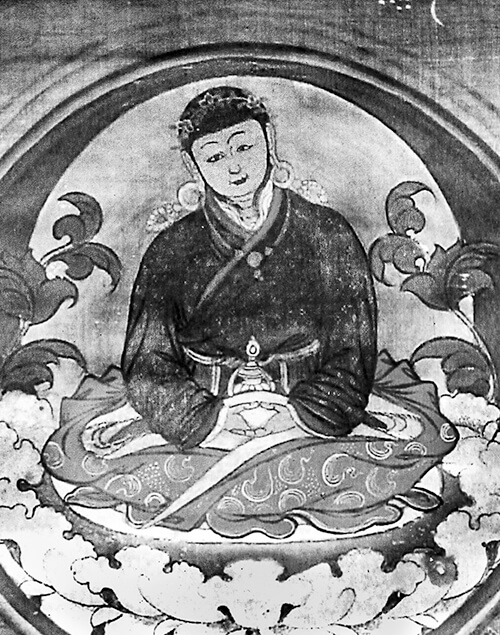
In general, although it is taught that there are six kinds of masters from whom you receive instruction, the masters who give the pith instructions are your root spiritual masters imbued with threefold kindness. Thus, no discourse or tantra relates a story of the attainment of enlightenment without that individual having relied upon a spiritual master. Each and every one of the highly accomplished masters who appeared in the past relied on material or nonmaterial spiritual masters, and developed all the qualities gained along the paths and stages of awakening; this is a matter of record. Therefore, your lamas have exhausted any flaws and have perfected all qualities: your lamas are the Buddha incarnate. Yet the mind-streams of us ordinary individuals are easily influenced by such things as conditions in our country, our historical period, or our companions. We must thus begin by examining spiritual masters from vantage points both close by and distant, then rely on them having set aside our negative thoughts or attitudes. In the end, having offered service by pleasing the lamas in three ways, and having kept tantric bonds without allowing them to be violated, we train so that our lamas’ wisdom mind and conduct are impressed upon us: our mind and conduct become like a clay image [satsa] emerging from a mold. This is very important.

Dudjom Rinpoche, mentioned above and one of the greatest masters of the 20th century, starts off his magisterial explanation of the foundational practices—A Torch Lighting the Way to Freedom: Complete Instructions on the Preliminary Practices, for those embarking on the path of Vajrayana Buddhism—with a long chapter titled “The Qualifications of Masters.”
He concludes it with:
Sublime teachers who are rid of all the faults just described and who possess all the right qualities are, because of the times, very hard to find—like the udumbara, the king of flowers. Even if they should happen to come across such teachers for just a little while, sentient beings with impure perception see faults in them—as has happened many times, starting with Devadatta who saw faults in the Bhagavan. Moreover, most people nowadays have the same store of negative deeds and misfortune, and so they perceive faults as good qualities and good qualities as faults. They see even those who have not a single ability that accords with the Dharma, whether manifest or hidden, as sublime beings, and so on. Those who know how to check are rare indeed. In particular, with regard to giving the profound teachings on the actual condition of things, teachers who have no realization cannot make the ultimate experience and realization develop in their disciples’ mindstreams. We should therefore take this point as a basis and regard a teacher who has most of the right qualities as the equal of the Buddha. The reason for considering even those in whom six of the above sets of qualities are complete and who have most of the right qualities as sublime beings and for following them is described in the Approach to the Absolute Truth:
Because of the age of strife, teachers have a mixture of faults and virtues:
There are none with no negative aspects at all.
Having carefully checked those who have more qualities,
Disciples should put their trust in them.
A Torch Lighting the Way to Freedom
$34.95 - Paperback
On Guru Yoga
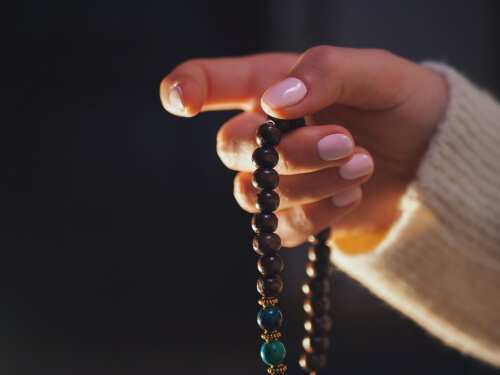
Whether our teachers present in person are ordinary beings or emanations of Buddhas or Bodhisattvas, if we are able to pray to them considering them as the Buddha, there is absolutely no difference between them and the Buddha or Bodhisattva or yidam deity in person, because the source of blessings is devotion. So whichever profound practice we are undertaking, whether the generation phase or the perfection phase, we should begin by making the teacher’s blessings the path. There is no more to it than that. But as long as we have not received the blessings, we will not be genuinely on the path. It is said that if disciples who keep the commitments give themselves wholeheartedly, with devotion, to an authentic diamond master, they will obtain the supreme and common accomplishments even if they have no other methods. But without devotion to the teacher, even if we complete the approach and accomplishment practices of the yidams of the six tantra sections, we will never obtain the supreme accomplishment. And we will be unlikely to accomplish many of the ordinary accomplishments either, such as those of long life, wealth, or bringing beings under one’s power. Even if we do manage to achieve a little, it will have necessitated a lot of hardship and will have nothing to do with the profound path. When unmistaken devotion takes birth in us, obstacles on the path will be dispelled and we will make progress, obtaining all the supreme and ordinary accomplishments without depending on anything else. This is what we mean by the profound path of Guru Yoga.
A Torch Lighting the Way to Freedom
$34.95 - Paperback

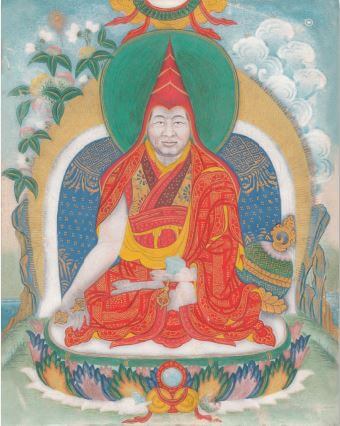
“There is one single criterion you should particularly check when examining a teacher: it is whether he has bodhichitta. If he has the bodhichitta, whatever sort of connection one makes with him will be meaningful. A good connection will bring buddhahood in one lifetime, and even a negative connection will eventually bring samsaric existence to an end.”
While one may not be so confident in their bodhicitta detection skills, the point is, after studying and analyzing the teacher, to use your own judgement.
If you wanted more detail, the author presents a more descriptive list of what characteristics to look for.
There are many other traditional overviews that include key instructions for evaluating, committing to, and following a teacher. From the tradition His Holiness the Dalai Lama was first educated in, Tsongkahpa’s The Great Treatise on the Stages of the Path to Enlightenment covers the subject over several pages. The great 18th-century adept Jigme Lingpa’s Treasury of Precious Qualities beautifully covers this as well.
A Guide to The Words of My Perfect Teacher
$34.95 - Paperback


- How to Seek the Wisdom Teacher
- The Justification for Following the Wisdom Teacher
- Categories and Characteristics of the Master Who Should Be Followed
- The Way in Which One Enters into and Goes Astray—Which Follows from the Characteristics of the Master
- The Characteristics of the Student Who Follows
- How to Follow
- The Necessity of Following the Wisdom Teacher in That Way
- Avoiding Contrary, Harmful Companions
- Creating Faith as a Favorable Condition
- The Way That the Wisdom Teacher Should Explain and the Student Should Listen to the Holy Dharma
Kongtrul relies on sutra and tantra sources to explain each of these. The reader will put it down having a much better appreciation for the scope of the Vajra master and student’s responsibilities, neither of which can be taken lightly.
The Teacher-Student Relationship
$24.95 - Paperback
By: Jamgon Kongtrul Lodro Taye & Ron Garry & Ven. Gyatrul Rinpoche & Lama Tharchin

Dangerous Friend: The Teacher-Student Relationship in Vajrayana Buddhism by Rig’dzin Dorje focuses exclusively on the Vajrayana aspects of the teacher-student relationship.

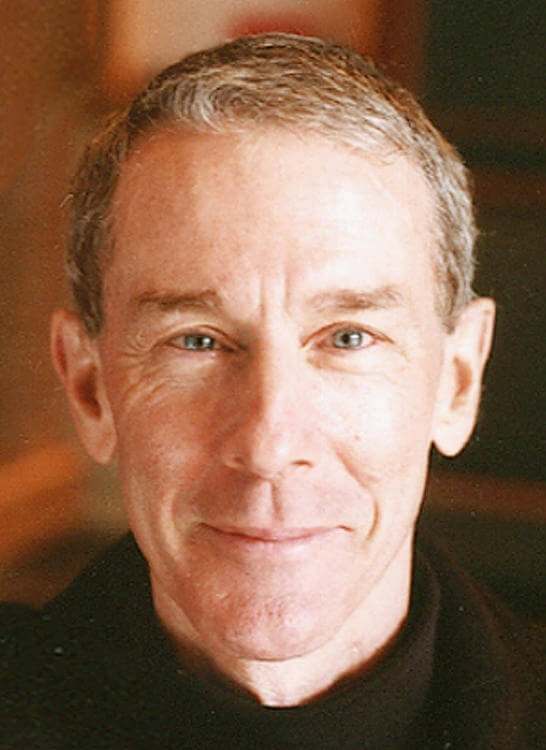
Many people are suspicious of Buddhism in general and particularly of the Vajrayana because of the intensity of the guru-disciple relationship. They are made uncomfortable by the level of projections that occur in the interaction of teacher and student. They do not like the lack of explicit restrictions, rules, and limitations on the relationship. They would prefer clear expectations and boundaries, without the uncertainty and intimacy that Vajrayana Buddhism implies.
Without denying the dangers in this as in all other intimate human relationships, and acknowledging that there can be no complete guarantee against mistakes and abuses, still there would appear something shortsighted in this point of view. As long as human beings live in the realm of samsaric duality, there is the inevitability of projection—in this case the positive projections of seeing something ‘‘out there’’ to which we are attracted and that we feel we need. What is sometimes not sufficiently realized is that no human beings are outside of this cycle.
Moreover, projection of this nature is not an inherently bad or undesirable thing. In fact, it is only because we are willing to project, willing to seek our dreams, that we can come up short and begin to integrate the part of ourselves that we had at first seen as outside. People do get ‘‘stuck,’’ but usually not forever. This process always involves vulnerability and suffering, but only in a culture that abhors pain and equates it with evil can one fail to see the transformative element.
The Vajrayana operates by eliciting and provoking the projections of our own deepest nature, then forcing us back on ourselves so that we have to integrate and take possession of those projections. This process is seen no more clearly than in the relation of teacher and student that forms the backbone of the path. Trungpa Rinpoche comments that at the beginning of the path, the teacher is seen virtually as a demigod. In the middle, he is experienced as a friend and companion. And at the end, when we have attained the state of realization that we once saw uniquely in him, he becomes inseparable from the inborn, living wisdom within.
What is sad is not to see this process of projection in Buddhism, where it can lead to something dignified and noble, but to see the way that it operates in the contemporary ‘‘modern’’ world, where it so often leads to an utter dead end. Here, people project their deepest yearnings onto things that have little to do with the human spirit and its maturation—new cars, upscale houses, clothes, vacations, credentials, fame, wealth, and power. It is not surprising, for example, that it is often among those who have succeeded most fully in realizing the materialism of the American Dream that one can find the most emptiness, fear, and unacknowledged despair.
Additional Resources
Another way to approach this is simply to read the stories of great masters and be inspired by their example. Here are a few places to get started:
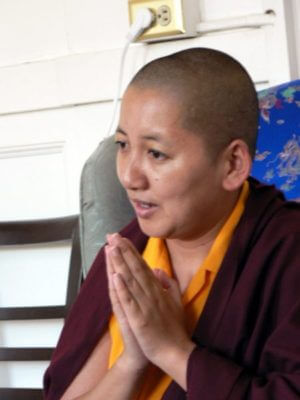
Khandro Rinpoche
Khandro Rinpoche discusses her teachers in her expansive Refuge chapter in This Precious Life: Tibetan Buddhist Teachings on the Path to Enlightenment
The incomparable lamas of the Longchen Nyintig tradition are presented in Tulku Thondup’s Masters of Meditation and Miracles.
The inspiring stories of Patrul Rinpoche are the subject of Matthieu Ricard’s collection of the oral history of this essential figure, Enlightened Vagabond.
The archetype of students, Milarepa, can be read about in many of the books included in our Reader’s Guide on him.
A subsequent article will address the related topic of Guru Yoga, which lies at the heart of the Vajrayana.

